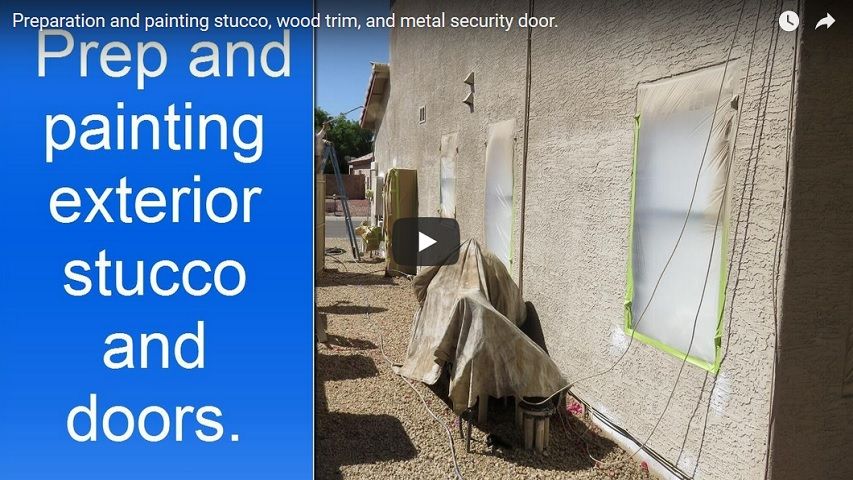
- Watch us on Youtube.
602-214-3040

602-214-3040
Painting exterior of a house in 8 steps with video examples.
The process of painting an exterior of the house will vary slightly from one painting contractor to another, as there are more than one way to complete an exterior painting project correctly, but most of the house painters will perform the same basic steps. On the bottom of this page there are a lot links to youtube videos with examples of preparation extarior surfaces for painting and application of paint.
Below are the steps that we take when painting a house exterior.
1. Pressure washing exterior.
Power washing cleans the house from all the dirt and dust that has build up, during many years since the last time the exterior has been painted and insures proper adhesion of the paint to the surface that is being painted. If there is gravel near the foundation of the house it needs to be moved a couple inches away from the foundation so when exterior is being sprayed the over-spray does not end up all over the gravel. Moving gravel a few inches away is usually done prior to pressure washing.
2. Scraping loose paint by hand.
If the exterior of the house has paint that is peeling, some of it may come off with pressure washing. However to get rid of all loose paint completely, it needs to be scraped thoroughly by hand. To scrape peeling paint we usually use putty knife. Sometimes if the surface is smooth (brick or wood surface, for example) a power tool can be used for loose paint removal. A wire brush attached to an angle grinder (using wire brush to remove loose paint video) or an orbital sander with rough sanding paper can work well.
3. Fixing cracks and holes.
Depending on the size of cracks different materials are used. The best way to fix hairline cracks is with elastomeric patch. It can be applied either with a brush or a mini roller. It comes out of the can a little thick and to thin it down so it is easier to work with we mix it with primer. There is no specific ratio. We add primer and try to apply it to the surface, and if it is still thick and does not come off the brush or roller easy enough we add some more primer until the patch reaches desired consistency. (Fixing hairline cracks video).
For medium size cracks we use regular latex caulk. We squeeze caulk out of the tube using caulking gun and then spread it evenly using a painter’s brush. So the caulk spreads easy we make sure the bristles of the brush are wet. We use a separate bucket with water where we keep the brush. Any brand of caulk will work well. The only type of caulk to avoid is siliconized caulk. The paint does not adhere to silicon. (Fixing medium size cracks video).
For larger cracks or holes we use stucco patch when we work on stucco surfaces, cement mix when we work on smooth masonry surfaces, and MH patching compound for cracks/holes in any other surfaces. (Fixing holes in stucco video).
4. Masking.
We mask windows, fixtures and cover driveways, walks, decks and plants around the house. Some of the surfaces is almost impossible to completely clean from over spray and it is always better to be safe than sorry, and making the effort to cover everything that is not being painted with plastic, paper and tarps, pays off every time.
We use twelve inch masking paper around the perimeter of the house anywhere where the foundation of the house meets the concrete floor. And cover the rest of the area either with plastic or tarps. We use plastic in the areas where we expect a lot of over-spray, such as front and back patios, for example when we spray paint patio ceilings. And we use tarps almost everywhere else.
We treat the second level of the house in the same way as the first floor. When working near roof tile we run twelve inch masking paper near the area that we are going to spray and cover the rest of the tile using tarps.
For the tape we prefer green tape for most exterior surfaces. It is more expensive than the yellow one but it has two main advantages: it sticks very well and it will not be blown away with minor wind and it also does not leave any residual glue on the surface after you remove it. It gives you three days of clean removal even in hot weather and in cooler weather can last five days on the surface without leaving glue upon removal. If more days on the surface are required we go with blue tape. Blue tape has very little adhesive and gives about seven days of clean removal but the main disadvantage is that it does not hold well and can come off easy when wind blows. And it does not stick well to any surfaces that are not smooth. We use blue tape only for specific areas: on the side gate metal, new light fixtures, very rarely on the windows.
If the tape is left on the surface for longer than it should have been and after removal there is residual glue on the surface, it can be easily removed with a rag and Goof off strength remover (from most of the surfaces). We put in a lot of effort to make sure there is no glue in the first place.
5. Priming unpainted surfaces.
Primer is usually required for all unpainted surfaces. Even when we use Super paint by Sherwin Williams that is paint and primer in one, we still use primer for all surfaces that never been painted before. If it is a large unpainted area we use a specialty primer. If the area is small or multiple areas of different type need to be primed we use general purpose primer such as Ultra grip by Dunn Edwards or Quick dry by Sherwin Williams.
(Using general purpose primer for new stucco and metal garage door video.)
For any repaired areas where we used elastomeric patch or latex caulk priming is not needed as those are paintable materials and the paint will adhere without any issues.
(House with a lot of repairs that do not require a primer video.)
6. Spray paint most of the exterior.
For most exteriors we use two different size of the spray tip. 4/13 is the tip we use for the larger surfaces (main color for the body of the house). And 4/11 is the smaller tip we use for any accent colors to spray paint the pop outs, doors and any areas where minimal overspray is desired. (Spray painting accent color using 4/11 size tip video).
Using spray extension pole helps to work faster and reach under the inner part of the trim and any other hard to reach areas easily (Spray painting using extention pole video).
When spray painting exteriors we apply two coats of paint. After painting one side of the house we go back and apply the second coat while we still have all ladders on that side.
All our extension ladders have ladder levelers that helps us to set up the ladder fast even on the most uneven surface, including the roof tile on the second level of the house, when working on exteriors of two story houses. (Ladder levelers on the roof tile of the house video).
Graco Ultra Max II 490 an airless paint sprayer that works great for any residential exterior painting is our choice of spray pump. It a strong pump that is able to support pressure in a very long hose and we take a full advantage of that. We have 4 fifty feet hoses connected together. With two hundred feet of hose we do not need to move the spray pump even once, for most exterior projects. We set the spray pump in the back yard on the tarp, that will catch any drips or spills from straining the paint, and we do not move it until we finished with spray painting entire exterior.
7. Brush and roll what is left, or mask and spray an accent color.
Depending on the color scheme we either spray the trim fascia or use a brush and a mini roller.
If the body part of exterior is being painted the same color as the fascia then we mask the roof tile and spray paint the fascia. If the trim fascia is a different color form the body most of the time we use a brush and mini roller for the accent color of the fascia. Here are some of the video examples of how we paint the trim:
(Painting trim using a brush and a mini roller video.)
(Masking roof tile to spray paint body and trim one color video.)
(Spray painting stucco trim an accent color video.)
8. Clean up.
The last step of exterior painting is to wait till the paint on the edges of plastic and paper that covers doors and windows dries, and clean the house from all protective materials.
Inspection.
We do an inspection of the house with the homeowner to see if everything looks the way it supposed to, prior to loading ladders on our truck and washing the brushes. It is a lot more cost effective to fix anything, if found during the inspection, than to get a call back from a homeowner and have to come back to touch up something that could have been addressed during isnpection.
Paints most commonly used for exterior projects in Phoenix.
Dunn Edwards paint that is often used by painting contractors because of its high quality, has few grades available and choice would depend on customer's budget. Most popular exterior paints are Versaflat , Acrihues and Spartashiled. All paint after it is applied to exterior surface will look the same. There is slight variation in sheen but in terms of looks there is no way to tell the difference between the most and the least expensive paint. The difference between the grades is how long the paint retains its color without fading. More expensive paints keep their original look for longer period of time. Also neutral colors fade a lot slower than dark or bright colors. We use paints from both Dunn Edwards and Sherwin Williams store with Sherwin Williams brand being our first choice.One gallon for two coats per 100sf would be a rough idea.
The amount of paint needed will vary depending on the type of paint used and the surface being painted.
Exterior stucco requires the most paint especially if the new color is much different from the one it is being painted over. One gallon would cover approximately 200sf. So for an average house that is about 1500sf for two coats of paint about 15 gallons would be needed. Brick or wood surface gives a little better coverage per square feet.
Buying a few paint samples can help you select colors for exterior house painting.
The easiest way to choose a color for your house is to go to a paint store after you get an idea of what you want by looking at color schemes and buy a few samples.Painting exterior of a house in Phoenix with elastomeric paint is not the best choice.
Elastomeric coating can be oil or water based. It it is formulated mostly to cover surface cracks and be a sealant against moisture. For elastomeric coating used in residential painting most often surfaces covered are concrete, brick or stucco. Elastomeric paints usually used in coastal communities where waterproofing is desirable, or areas where it rains a lot during the year. Elastomeric paints usually do not chalk which makes them very long lasting. Being long lasting paints, holding the moisture out and hiding the cracks, those are the advantages of the elastomeric paints.
However there are some disadvantages.
A gallon of elastomeric paint will cover about 80sf per gallon, when most of the paints used for exterior painting will usually give you 200-300 sf per gallon. In addition of covering very small area per gallon, elastomeric paint is expensive. It is about $130 for 5 gallons, when water based 100% acrylic Dunn Edwards paints start at $85 for 5 gallons (all contractor pricing).
Elastomeric paint requires very good surface preparation and high pressure gas sprayer(most electric sprayers won't do the job).
If moisture gets behind elastomeric paint it may become trapped with nowhere to go, blow up like a balloon and the paint will come off. If moisture gets behind regular paint, it usually cracks and this crack can wait till next painting job, and be fixed during preparation process.
The cost of painting the house with elastomeric paint will be a higher, comparing to best premium water based 100% acrylic paints, and in Phoenix metro with so little rain fall will be hard to justify.
If you do decide to hire a painting company
to paint your exterior with elastomeric paint, it is imperative to make sure the painting contractor has experience in applying these type of coating, as elasomeric painting job gone bad is not a pretty sight.
Currently we do not offer painting using any kind of elastomeric paint.
Some of the painting mistakes homeowners make, when painting an exterior of a house without hiring professional painters.
Exterior painting of a home is almost never a do it yourself project.
The paint exposed to nature elements (sun, heat) and there is just too many reasons why paint could fail if not applied properly, or surface is not properly prepared. Below are five most common mistakes home owners make when painting a house exterior.
1. House is not power washed prior to painting or the power washer doesn't have high enough pressure.
Usually power washer with less than 2500 psi (pressure per square inch) will not do a good job in power washing the house.
2. Not scraping loose paint by hand.
If the house has a lot of pealing paint, some of it will come off after the house is power washed. But power washing along will not solve the problem. Scraping loose paint by hand will ensure that all the paint that is about to fall off, will come off before the new paint is applied. Otherwise new paint will fall off with the chunks of the old paint.
3. Not sealing areas that are chalky.
If there is chalk on the surface it will not go away with pressure washing. Any chalky surfaces need to be sealed. Sealkrete would be one one of the best sealers to use for this type of problem.
4. Not using the right type or of paint or primer. Or the right type but of a low quality products.
There are different types of paints and primers for a reason. Not using the proper type or primer of paint manufactured for a particular surface could reduce the life of a painting job significantly.
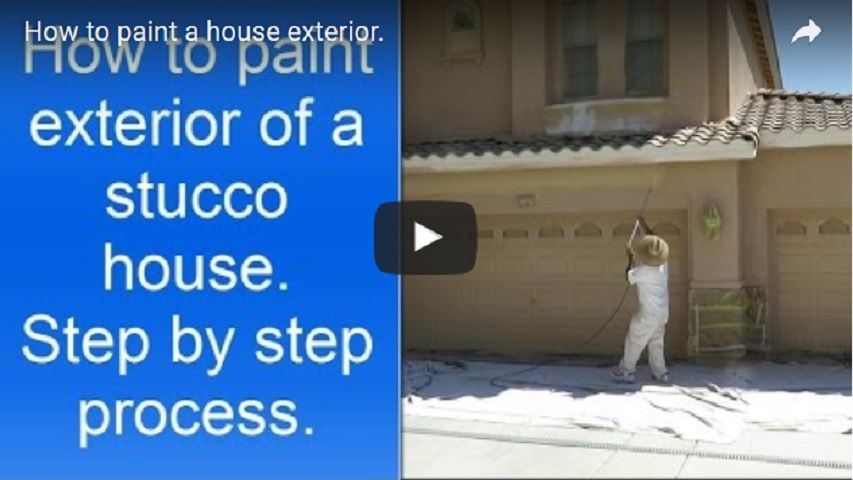
Spray painting exterior two story stucco house.

Painting exterior two story stucco house.
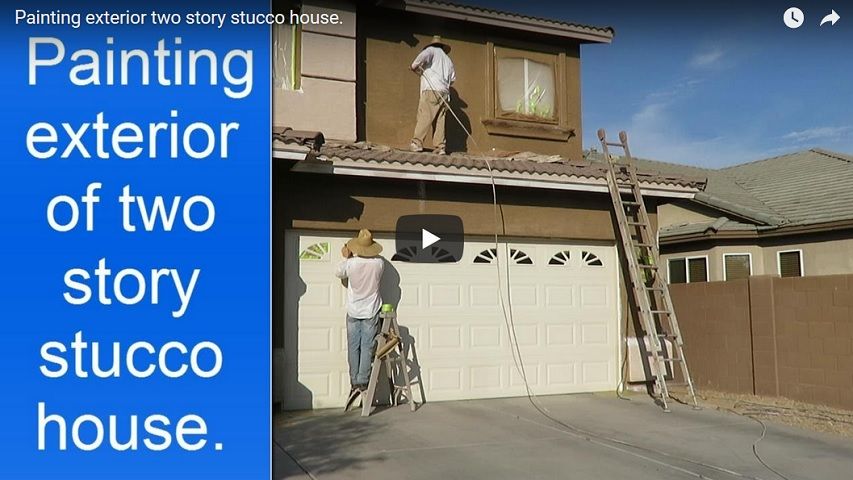
Exterior spray painting of stucco house.
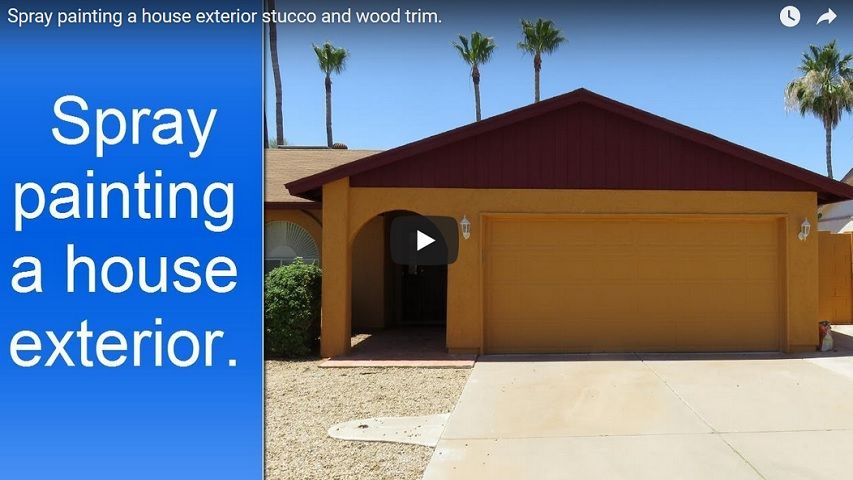
Spray painting a house exterior stucco and wood trim.
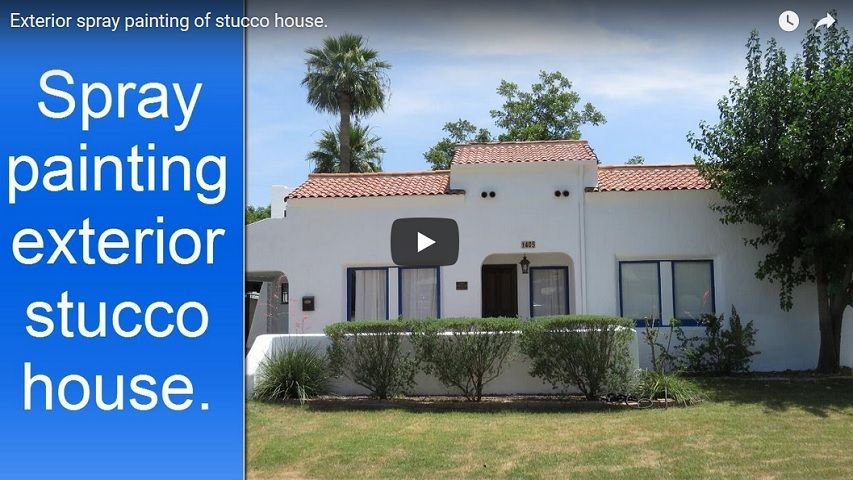
Spray painting exterior of a stucco house.
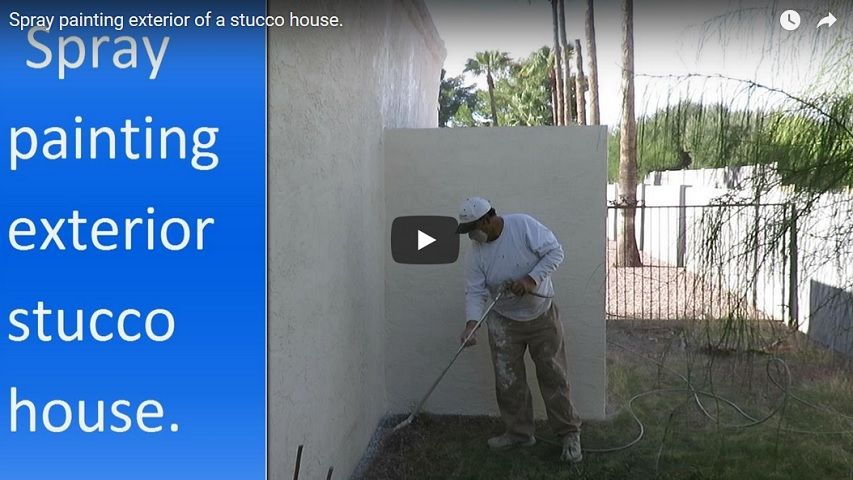
Preparation work and spray painting exterior stucco house with wood trim.

Preparation and painting exterior stucco, wood trim, and metal security door.
